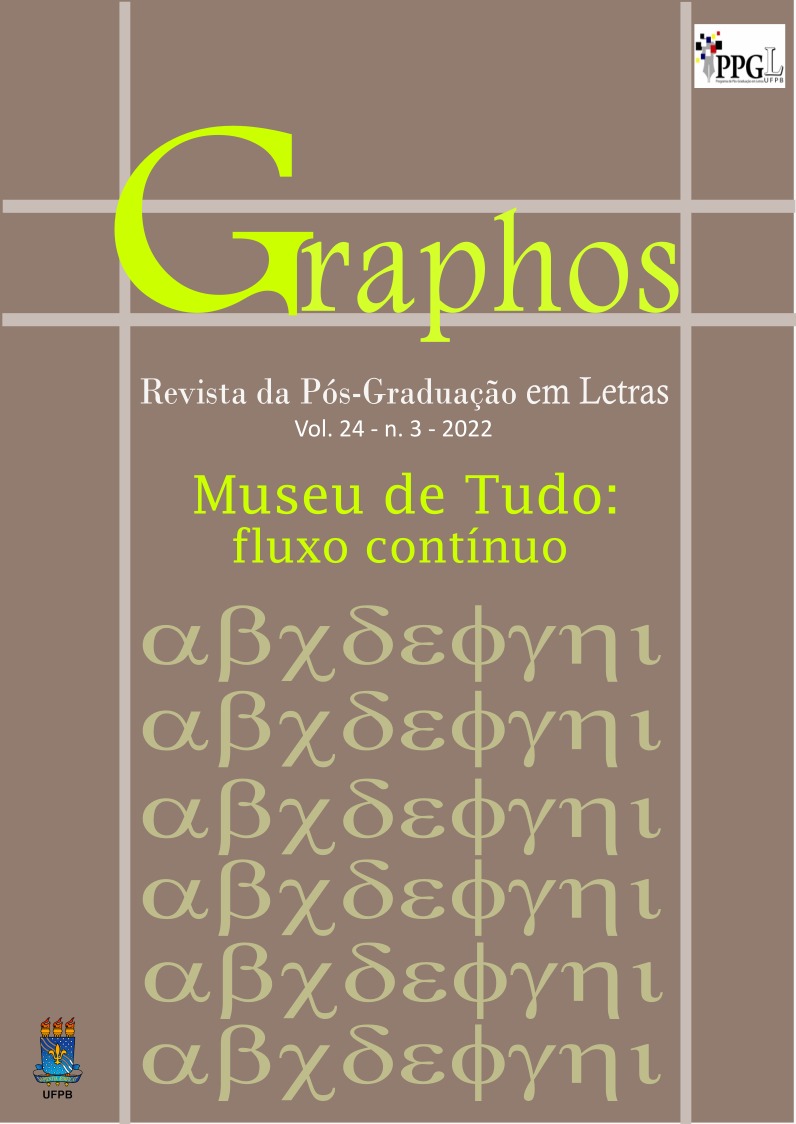Life is a zoo: a comparative reading of Albee’s The zoo story and Lispector’s “O bufalo”
DOI:
https://doi.org/10.22478/ufpb.1516-1536.2022v24n3.64278Keywords:
Animality, Zoo, Looking , Clarice Lispector, Edward AlbeeAbstract
This work aims at analysing, from a comparative perspective, the play The zoo story by Edward Albee (1959), and the short story “O búfalo” by Clarice Lispector (1960). We will analyse, from Animal Studies (DERRIDA, 2002; MACIEL, 2008, 2011; BRAVO, 2011; SILVA, 2020; HARAWAY, 2021), the way the zoo is portrayed in each text, regarding its virtual presence in the play and the actual in the short story as well as the historical construction of this place, between control and preservation. Furthermore, we will investigate the interspecific relationship – mirroring and complementing – between animality and humanity in the formation of the characters, because there is, in each text, a distinct dialogue between humans and non-human animals by means of the looking. Besides, we will analyse the way fiction is presented while a form of bio-perspective speculation, which allows the readers to rethink their own animal condition e to destroy the speciesism of western thinking. Thus, we will defend the thesis the zoo may be read as a metaphor for life, since, in both works, there is social control by power relations and inversion between animals and humans by looking, in other words, by empathy.
Downloads
References
AGAMBEN, Giorgio. O aberto: o homem e o animal. Tradução Pedro Mendes. Rio de Janeiro: Civilização Brasileira, 2013.
ALBEE, Edward. The zoo story. Disponível em:
p. 1-21. Acesso em: 10 jun. 2022.
BARATAY, Eric; HARDOUIN-FUGIER, Elisabeth. Zoo: a history of zoological gardens in the west. London: Reaktion, 2004.
BERGER, John. Animais como metáfora. Tradução Ricardo Maciel dos Anjos. Suplemento Literário de Minas Gerais. Edição 1.332, p. 6-9, 2010.
BRAVO, Álvaro Fernández. Desenjaular o animal humano. In: MACIEL, Maria Ester (Org.). Pensar/escrever o animal: ensaios de zoopoética e biopolítica. Florianópolis: Editora da UFSC, 2011, p. 221-244.
COCCIA, Emanuelle. A vida das plantas – uma metafísica da mistura. Florianópolis: Cultura e Barbárie, 2018.
COETZEE, John.M. Elizabeth Costello. São Paulo: Companhia das Letras, 2004.
DERRIDA, Jacques. O animal que logo sou (A seguir). Tradução Fábio Landa. São Paulo: Editora da UNESP, 2002.
EAGLETON, Terry. Literary theory: an introduction. Minneapolis: The University of Minnesota Press, 1996.
ESSLIN, Martin. Absurd Drama: introduction to “Absurd Drama”. New York: Penguin, 1965.
FERREIRA, Ermelinda. Metáfora animal: a representação do outro na literatura. Estudos de Literatura Brasileira Contemporânea, Brasília, (26), p. 119–135, 2011.
FOUCAULT, Michel. De espaços outros. Estudos Avançados, São Paulo, n.79, vol. 27, p. 113-122, 2013. Disponível em: <https://www.revistas.usp.br/eav/article/view/68705/71285> DOI: https://doi.org/10.1590/S0103-40142013000300008
FREUD, Sigmunt. Obras completas - Volume 18. Tradução Paulo César de Souza. São Paulo: Companhia das Letras, 2010.
HARAWAY, Donna. O manifesto das espécies companheiras: cachorros, pessoas e alteridade significativa. Tradução Pê Moreira. Rio de Janeiro: Bazar do Tempo, 2021. E-book.
KOUTSOUKOS, Sandra Sofia Machado. Zoológicos humanos: gente em exibição na era do imperialismo. Campinas: Editora da UNICAMP, 2020. DOI: https://doi.org/10.7476/9786586253313
LESTEL, Dominique. A animalidade, o humano e as ‘comunidades híbridas’. In: MACIEL, Maria Ester (Org.). Pensar/escrever o animal: ensaios de zoopoética e biopolítica. Florianópolis: Editora da UFSC, p. 23-54, 2011.
LEVI-STRAUSS, Claude. Raça e história. Raça e Ciência. São Paulo: Perspectiva, 1960. p. 231-266.
LISPECTOR, Clarice. O búfalo. Laços de família. Rio de Janeiro: Rocco, 2016, p. 248-257.
LISPECTOR, Clarice. A descoberta do mundo. Rio de Janeiro: Rocco, 1999a.
LISPECTOR, Clarice. A paixão segundo G.H. Rio de Janeiro: Rocco, 1999b.
LISPECTOR, Clarice. A hora da estrela. Rio de Janeiro: Rocco, 2017.
MACIEL, Maria Esther. O animal escrito: um olhar sobre a zooliteratura contemporânea. São Paulo: Lumme, 2008.
MACIEL, Maria Esther. A vida dos outros. Aletria, Belo Horizonte, n. 3, v. 21, p. 91-100, 2011. DOI: https://doi.org/10.17851/2317-2096.21.3.91-101
NASCIMENTO, Evando. Rastros do animal humano – a ficção de Clarice Lispector. E-scrita, Belford Roxo, v. 10, n. 1, 2019.
MACIEL, Maria Ester (Org.). Pensar/escrever o animal: ensaios de zoopoética e biopolítica. Florianópolis: Editora da UFSC, 2011, p. 117-148.
MARTIN, Natassja. Escute as feras. São Paulo: Editora 34, 2011.
NODARI, Alexandre. Filozoofia. Revista Canguru. n. 2. Curitiba: Medusa, p. 21-27, 2017.
PLUMWOOD, Val. Feminism and the mastery of nature. London: Routledge, 1993.
SAAVEDRA, Carola. Mundo desdobrável: ensaios para depois do fim. Belo Horizonte: Relicário, 2021.
SAER, Juan José. O conceito de ficção. Sopro: panfleto politico-cultural, n. 15. Tradução Joca Wolff. E. p. 1-4, 2009.
SANTIAGO, Silviano. Bestiário. Ora direis, puxar conversa!. Belo Horizonte: Editora da UFMG, 2006, p. 157-192.
SILVA, Ana Carolina T. P. Os animais na literatura brasileira: do imperialismo ecológico ao animal enquanto sujeito. 280f. Tese (Doutorado em Estudos Literários). Universidade Federal do Paraná, 2020.
VIVEIROS DE CASTRO, Eduardo. A inconstância da vida selvagem – e outros ensaios de antropologia. São Paulo: Cosac & Naify, 2014.
Downloads
Published
Issue
Section
License
Copyright (c) 2023 Camila Marchioro, Letícia Pilger

This work is licensed under a Creative Commons Attribution 4.0 International License.







